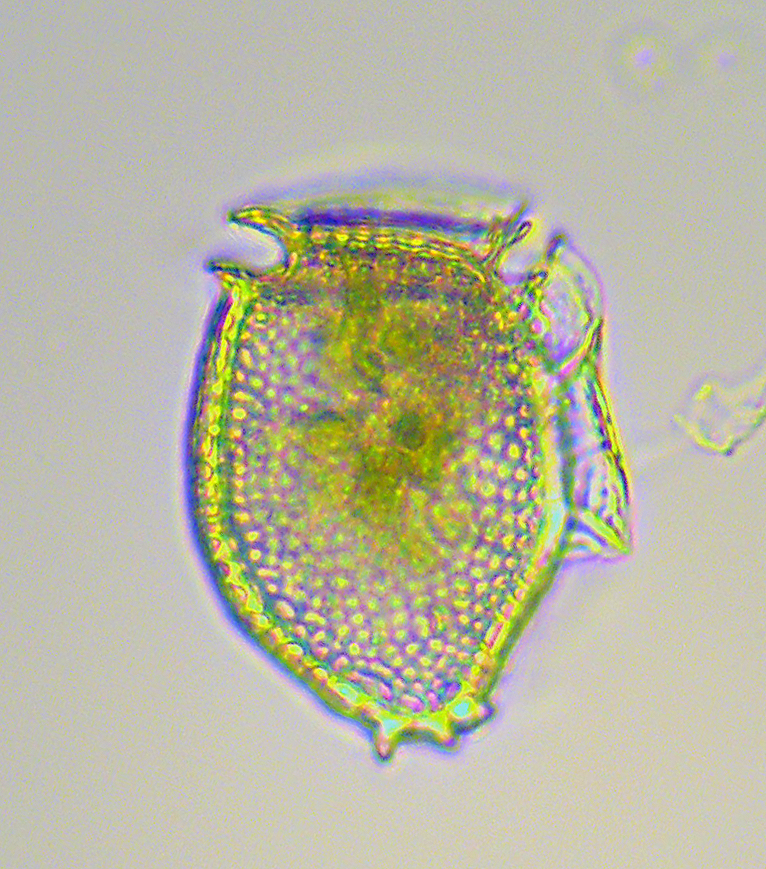Diarrhetic Shellfish Poisoning
Causative organisms: Dinophysis spp. (D. acuminata, D. acuta, D. caudata, D. fortii, D. infundibula, D. miles, D. norvegica, D. sacculus, D. tripos, D. ovum), Prorocentrum spp.
Toxins implicated: Okadaic Acid, dinophysistoxin(s), and congeners
Diarrhetic Shellfish Poisoning (DSP) produces gastrointestinal symptoms, usually beginning within 30 minutes to a few hours after consumption of toxic shellfish. Although not fatal, the illness is characterized by incapacitating diarrhea, nausea, vomiting, and abdominal pain. Recovery usually occurs within three days, with or without medical treatment. Of the ~100 Dinophysis species, only 10 are known to produce diarrhetic toxins (okadaic acid and dinophysistoxins). Many of the species that produce diarrhetic toxins also produce another toxin group called pectenotoxins, which have not been linked to human illness, but still accumulate in shellfish and are regulated in some parts of the world. Species of the morphologically similar "D. acuminata-complex" (mainly D. acuminata, and D. ovum) are most common in the US; however, toxic species such as D. fortii and D. norvegica are also present. Toxin profiles and toxicity can be highly variable, especially among strains, and varies by region (Reguera et al. 2014). Even at low cell densities (<103 cells·L−1), toxic Dinophysis spp. are a threat because they are concentrated by shellfish (mussels, clams, oysters, scallops), but the number of cells required to make shellfish toxic can also vary greatly by species and geographic region. Cooking or freezing contaminated shellfish will not eliminate the toxins. Effects of chronic exposure are not well known; however, a possible association between exposure to DSP toxins and digestive cancers has been suggested (Cordier et al. 2000).
U.S. Finfish and Shellfish Vectors of DSP
| Harmful Algal Species | Geographic Area | Affected Organisms* |
|---|---|---|
| Dinophysis acuminata Dinophysis acuta Dinophysis caudata Dinophysis fortii Dinophysis infundibula Dinophysis miles Dinophyisis norvegica Dinophysis ovum Dinophysis sacculus Dinophysis tripos Prorocentrum lima+ | NE Atlantic Coast Washington California Gulf of Mexico Gulf of Maine | Mussels Scallops Clams Oysters |
| *Found to contain algal toxins, or to be adversely affected by toxic or harmful marine algae. +Linked with DSP events in North America (Nova Scotia). |
||
Additional resources:
- Cordier, S., Monfort, C., Miossec, L., Richardson, S. and Belin, C., 2000. Ecological analysis of digestive cancer mortality related to contamination by diarrhetic shellfish poisoning toxins along the coasts of France. Environmental research, 84(2), pp.145-150.
- Deeds, J.R., Wiles, K., VI, G.B.H., White, K.D. and Abraham, A., 2010. First US report of shellfish harvesting closures due to confirmed okadaic acid in Texas Gulf coast oysters. Toxicon, 55(6), pp.1138-1146; https://doi.org/10.1016/j.toxicon.2010.01.003
- Reguera, B., Riobó, P., Rodríguez, F., Díaz, P., Pizarro, G., Paz, B., Franco, J. & Blanco, J. 2014. Dinophysis Toxins: Causative Organisms, Distribution and Fate in Shellfish. Mar. Drugs 12:394.-461; doi:10.3390/md12010394
- Tong, M., Smith, J.L., Richlen, M., Steidinger, K.A., Kulis, D.M., Fux, E. and Anderson, D.M., 2015. Characterization and comparison of toxin‐producing isolates of Dinophysis acuminata from New England and Canada. Journal of phycology, 51(1), pp.66-81.Yasumoto, T. and Murata, M., 1990. Polyether toxins involved in seafood poisoning. In ACS symposium series (Vol. 418, pp. 120-132). Oxford University Press; doi: 10.1111/jpy.12251
- Yasumoto, T., Murata, M., 1990. Polyether toxins involved in seafood poisoning. In: Hall, S., Strichartz, G. (Eds.), Marine Toxins: Origin,Structure, and Molecular Pharmacology. American Chemical Society,Washington D.C., USA, pp. 120–132;
Medical Community
Diarrhetic Shellfish Poisoning
Additional Information on DSP including: Background, Clinical Presentation, Diagnosis, Management and Treatment, Chemical Structure, and Molecular Mechanism of Action.


